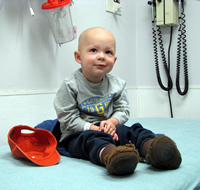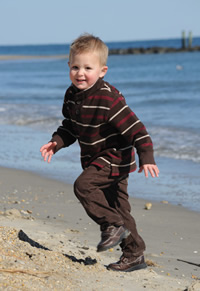Ground-breaking therapy improves outcomes for children with an aggressive form of cancer.
 By the time pediatric oncologist Eric Lowe explained to Jackson Bensten’s family what was ahead for their toddler, they already suspected that the news would be bad.
By the time pediatric oncologist Eric Lowe explained to Jackson Bensten’s family what was ahead for their toddler, they already suspected that the news would be bad.
Jessica Bensten had discovered a huge lump in her son’s abdomen when changing his diaper one Sunday afternoon in February 2009. The week that followed at Children’s Hospital was filled with anxious speculation as Jackson went through tests, radiology scans and biopsies. Jessica and her husband, Everett, braced for the diagnosis of some type of cancer.
Their fears were confirmed when Dr. Lowe explained to them that the mass in Jackson’s tummy was neuroblastoma, a type of childhood cancer that strikes about 650 children a year. “There are several forms of neuroblastoma,” Dr. Lowe explained. “Some are highly treatable with encouraging survival rates. But nearly half of all neuroblastoma cases are what we call high-risk neuroblastoma, a very aggressive form with a much graver prognosis.”
Thirteen-month-old Jackson had the aggressive form of the disease.
Dr. Lowe told the Benstens that the five-year survival rate for this type of cancer in children was only around 40 percent, with relapse commonly recurring in a few years. But he also gave them a glimmer of hope. “He told us that a new therapy was improving those odds,” Jessica remembers.
Called immunotherapy, the new treatment is an add-on to conventional cancer treatment. “It comes after all other treatments are completed to mop up any remaining cancer cells that the other treatments missed,” says Dr. Lowe.
Jackson could participate in a clinical trial of immunotherapy at CHKD, but Dr. Lowe warned Jessica and Everett that the treatment plan would be extremely difficult.
First, Jackson would go through six rounds of inpatient chemotherapy. He’d have surgery to remove his tumor during one of the later rounds of chemo. After that, he’d be given another, higher-dose round of chemo and stem cell rescue. Next on the list: radiation therapy. Only after Jackson endured all that would he begin immunotherapy, it would be the toughest treatment of all.
The prospect of putting their toddler through this was frightening for the Benstens. But the couple also wanted to give Jackson the very best chance of surviving his disease. “This new therapy was improving survival rates by 20 percent,” Jessica said. “We knew we’d have lots of emotional and physical support because Jackson is the first grandchild on both sides of our family. If it meant giving Jackson a 20-percent better chance of staying cancer free, we knew we could do it.”
 So on February 16, 2009, Jackson entered the clinical trial at Children’s Hospital of The King’s Daughters, a short trip from their home in Hampton.
So on February 16, 2009, Jackson entered the clinical trial at Children’s Hospital of The King’s Daughters, a short trip from their home in Hampton.
Jackson’s initial treatment consisted of three rounds of inpatient chemotherapy. “It made him sick at first, but he bounced back between each round,” Jessica said.
In early March, CHKD oncologists retrieved and stored Jackson’s stem cells to restore his blood and immune system during the stem cell transplant phase later that summer. Surgery to remove the tumor took place soon after.
“Jackson was a trouper through it all,” Jessica recalls.
After recuperation from surgery, the second three rounds of inpatient chemotherapy took place. By springtime, Jackson’s CT scans showed no signs of cancer, and the entire Bensten family was rallying around this charming little guy who was fighting a really bad disease.
But Dr. Lowe had prepared Jessica and Everett to expect that Jackson’s worst days were yet to come.
In mid-summer, Jackson returned to CHKD for more than a month. At first, he received high doses of chemotherapy that wiped out his bone marrow before his own stem cells were returned to his body to build new bone marrow.
Jessica says she was rarely away from Jackson’s side during this intensive phase. “The hem/onc staff was there for us the entire time,” she said. “So were the child life specialists and chaplains. Everyone helped us through it.”
After a brief recuperation at home, Jackson returned to the hospital for radiation therapy in preparation for the final step in his treatment – the immunotherapy.
 “The immune system normally recognizes unusual cells in the body and destroys them,” Dr. Lowe explains. “Cancer occurs when something in this process malfunctions and the unusual cells are allowed to grow. That’s a really basic definition of cancer.
“The immune system normally recognizes unusual cells in the body and destroys them,” Dr. Lowe explains. “Cancer occurs when something in this process malfunctions and the unusual cells are allowed to grow. That’s a really basic definition of cancer.
“What immunotherapy does is put your own immune system back in the game,” he continued. “First, we give the patient an antibody that targets a substance on neuroblastoma cells. After the antibody treatment has raised a red flag on the remaining neuroblastoma cells, we give the patients medications that boost the immune system, giving it a better chance of killing whatever neuroblastoma cells are left.”
Dr. Lowe gave Jackson five cycles of immunotherapy between October ’09 and February 2010. “He got so sick,” Jessica recalls, her voice getting softer as she explained. “These were really strong drugs. Jackson had a lot of pain and a strong reaction to the medications. His doctors kept adjusting doses until he could tolerate the treatment.”
Dr. Lowe explained that the toxicity of the treatment can cause a range of reactions, including pain, low blood pressure, systemic inflammation, fluid in the lungs and fever. Jackson slowly improved in the weeks that followed, and though the treatment was very difficult, his physicians were pleased with how well he tolerated it.
“Make no mistake,” said Dr. Lowe. “Jackson’s treatment was tough.”
But so was Jackson. By February, with the hardest part behind, Jackson received oral doses of follow-up medication and had occasional CT scans to make sure the cancer was not returning.
For the Bensten family, March 2011 will mark one year since the end of their son’s treatment.
“I know that we have to be vigilant now. And I admit I get nervous every time he gets a cold or has a fever,” Jessica said. “But we constantly hope that Jackson will be one of those children who survive neuroblastoma.”
“Previous trials have shown that neuroblastoma patients who live without disease for two years after stem-cell transplant will most likely be cured,” Dr. Lowe said.
These are words of hope for Jessica and Everett Bensten.
In the meantime, they are raising a very energetic little boy. “He loves his doctors and nurses at CHKD and doesn’t mind going for his checkups,” Jessica said. “He has suffered some hearing loss from the chemo, so he’s getting help from speech therapists at CHKD, and he has hearing aids in both ears.”
Though his hearing deficit serves as a reminder of Jackson’s grueling treatment, his mother believes it is a minor inconvenience in comparison to the hope that treatment offered. “It was really hard to watch him go through all that,” she said. “But we all survived, and we are strong believers that Jackson will have the good outcome we hope for.
“You want your kids to be happy and healthy. You just can’t let cancer change your perspective.”
Dr. Lowe practices with Children’s Specialty Group PLLC at CHKD.
The oncologists at CHKD are members of Children’s Oncology Group, an international pediatric cancer research collective that brings the newest treatments and clinical trials to patients around the world – and right around the corner at CHKD.
This story was featured in the first quarter 2011 issue of KidStuff, a publication of Children's Hospital of The King's Daughters. Click to read more patients' stories.